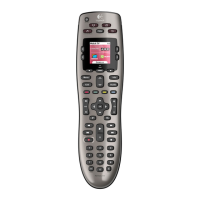Page 3
2. If the keypad backlight goes on when you press a button using normal pressure, then the actual button
hardware is ne and any issues you may be having are not related to button failure. However, if you need
to press multiple times, or with force, then there is something wrong with the actual button and/or contact
surface. You can test every button exactly the same way and it does not matter if the button is mapped for
use or not.
3. If none of the hard-buttons are working, but the touch screen buttons are working, this symptom can be
caused by a partially stuck button or a glitch in the rmware. So, rst check for these possibilities. To test
for a partially stuck button, massage each button to ensure that it has the correct travel and does not feel
like it is partially depressed. Press each button rmly and see if there is any difference in travel. Often, but-
tons near the bottom of the remote, where the front cover begins to narrow, can become partially stuck. If
all the buttons feel like they are moving correctly, then it’s time to check for a power or rmware glitch. Try
doing a battery-pull, wait 30 seconds and re-install. If the buttons are still not working, then try re-applying
the Firmware using the Harmony Software. If there is still no change in behavior, the remote cannot be
repaired and logic board replacements for the Harmony 900 are usually not available, but check with us.
Harmony 1000/1100
The Harmony 1000/1100 uses tactile button domes; small, convex metallic discs that, when pressed down,
make contact with the corresponding pad on the PCB. These discs can deform with time or develop microscop-
ic pitting and corrosion and, most often, these tactile domes require replacement as cleaning the underside of
the dome and pad on the PCB is not effective. Each button should respond with a light touch. If you need to
use even slightly more pressure to activate a button (we call this ‘lazy’), it is usually a good idea to replace it.
This is the procedure:
1. Place the remote down on a at surface and, without starting any Activity, allow the LCD to go to ‘sleep’
(turn off). Now, without jostling the remote, so as not to disturb the tilt-sensor (motion sensor), press down
on any button that you suspect is not working. This should be done in a slightly darkened room, as you will
need to watch if the keypad backlight goes on. Note that with the Harmony 1000/1100, the LCD will not
go on when any of the hard-buttons on the pad to the right of the LCD are pressed, so the LCD cannot be
used for this testing.
2. If the keypad backlight goes on when you press a button using normal pressure, then the actual button
hardware is ne and any issues you may be having are not related to button failure. However, if you need
to press multiple times, or with force, then there is something wrong with the actual button and/or contact
surface. You can test every button exactly the same way and it does not matter if the button is mapped for
use or not.
3. If none of the hard-buttons are working on the hard-button keypad, but the Activities and Off button are
working, then the hard-button PCB board is defective and must be repaired or replaced. This is not a tactile
dome problem, but is generally caused by damage to the ribbon cable that attaches this small board to the
main PCB.
Questions? Need additional help? Contact us at info@harmonyremoterepair.com
www.harmonyremoterepair.com

